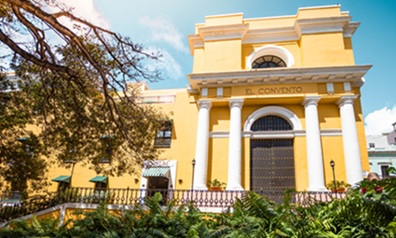
WASHINGTON, D.C.—Historic Hotels of America, the official program of the National Trust for Historic Preservation for recognizing and promoting the finest historic hotels in the United States, announced The 2025 Top 25 Historic Hotels of America Best of Adaptive Reuse list. A popular and creative approach to historic preservation, adaptive reuse saves unused historic buildings from demolition by rehabilitating and renovating them to serve a new purpose. Travelers can visit many historic inns, resorts, and hotels in the United States today because their owners chose to reimagine these historic buildings in sustainable and creative ways. These adaptive reuse hotels inducted into Historic Hotels of America offer travelers an immersive, authentic, and fun way to experience historic preservation on their next trip.
Released during Preservation Month, The 2025 Top 25 Historic Hotels of America Best of Adaptive Reuse list spotlights 25 richly preserved historic buildings that were not originally built to be hotels. Guests can spend the night on a former luxury ocean liner, dine in a fire station, and swim in the hotel pool at a historic YMCA. One historic hotel featured on the list is a former junior high school that embraces its past with “hall pass” guestroom keycards and signature cocktails like the Prom Queen. Another historic hotel featured on the list is a former train station that curated train car-themed suites, named after the ticketing agents who once worked there. These hotels are proof that historic buildings can offer modern amenities while preserving their timeless character.
This month, the nation’s leading preservation nonprofit is shining a spotlight on the ways in which history and heritage are preserved in the United States, and on the people who are doing this important work. The theme this year honors those who are “Harnessing The Power of Place” —what historic hoteliers do every day for their guests.
For more information, visit HistoricHotels.org and sign up for Discover & Explore to stay up to date on news and special offers.
The following are five of the properties included on the Top 25 list.
El Convento Hotel (1646) San Juan, Puerto Rico
Located within the historic walled city of Old San Juan, El Convento Hotel was built over 350 years ago as a Roman Catholic convent for nuns of the Carmelite Order. The land was donated to the Order by Doña Ana Lanzós, a wealthy widow, in the early 1600s, but construction was delayed while labor and material resources were redirected to build the city’s fortifications. In 1646, King Phillip IV of Spain approved the convent, and San Juan finally had its beautiful new convent. Debuting as the Monasterio del Señor San José de la Orden de nuestra Señora del Carmen in 1651, the convent welcomed three nuns from Hispaniola as its first residents. For nearly 250 years, the convent was one of the Caribbean’s major Catholic facilities, often providing support to the Catedral Basilica Menor de San Juan Bautista—the second-most historic cathedral in the Americas. In 1903, the convent closed. The Bishop of Puerto Rico determined that the convent was too expensive to maintain, and the building faced an uncertain future for 50 years. In the mid-20th century, Robert Woolworth stepped in and invested in the complete rehabilitation of the building, ultimately transforming the historic convent into a stunning, boutique hotel. Reborn as El Convento Hotel, it soon emerged as one of the most popular vacation destinations in all of San Juan. In fact, numerous celebrities—including Rita Hayworth and Truman Capote—were among the first guests to step inside. Further restorations and renovations have rejuvenated the building’s historical and structural integrity, revitalizing the Spanish-style design features of the original convent, such as the architectural details throughout the building’s façade. Among other historic features, a 300-year-old níspero fruit tree stands in the historic courtyard. El Convento Hotel was inducted into Historic Hotels of America in 1999 and dates to 1646.
Woolverton Inn (1792) Stockton, New Jersey
The bucolic Woolverton Inn and Northridge Restaurant exemplify the power of adaptive reuse in preserving history while offering modern amenities. This stunning destination is located on an estate with a beautifully restored manor house that dates to 1792, and a stone barn that dates to the 1830s, each repurposed to create a unique guest experience rooted in historic charm and sustainability. The manor house was originally built as an unassuming, two-story farmhouse in 1792. The early residents of the farm cultivated linseed and grain on the land and maintained a fruit orchard. It remained a private residence until the early 1980s, when it was carefully converted into an elegant country inn. The transformation preserved original details—including grand fireplaces, wide plank flooring, and hand-hewn beams—while integrating luxurious, modern amenities. Today, the manor house, along with its thoughtfully built cottages, welcomes guests seeking a historic yet refined retreat. The estate’s stone barn was meticulously restored and repurposed into Northridge Restaurant, a fine dining destination and event venue. While maintaining its rustic stone walls, soaring wooden beams, and original structural elements, the space has been outfitted with modern amenities to accommodate intimate dinners, weddings, and other celebrations. This transformation honors the barn’s agrarian history, while offering guests an immersive and atmospheric dining experience. By repurposing these existing buildings rather than constructing new ones, Woolverton Inn strategically minimizes its environmental impact while retaining its rich architectural heritage. Woolverton Inn was inducted into Historic Hotels of America in 2023 and dates to 1792.
The Blackburn Inn and Conference Center (1828) Staunton, Virginia
The Blackburn Inn and Conference Center dates to 1828, when the Virginia State Government built Western State Hospital on 80 acres in Staunton, Va. Soon after it opened, the hospital administrators hired architect Thomas R. Blackburn to expand the medical campus. Blackburn was a respected architectural protégé of former U.S. President Thomas Jefferson. Blackburn directed the magnificent renovation of the complex, which saw the addition of spacious room wings, verdant gardens, and a magnificent cupola on top of the main hospital building. He aimed to create a place of healing that was as beautiful as it was useful. When construction concluded in 1836, the Western State Hospital stood as an architectural masterpiece. The hospital moved out of these buildings in the 1970s, and portions of the medical campus have been repurposed since then. In the early-21st century, investors acquired several buildings on the medical campus. After undergoing a long and careful renovation, The Blackburn Inn and Conference Center opened in Summer 2018, and was inducted into Historic Hotels of America that same year. The boutique hotel merges modern amenities and historic architectural details, along with elegant touches. The unique architectural features in The Blackburn Inn include the original heart pine floors and classical molding around the doorways. The transom windows on the third floor were the inspiration behind the inn’s logo. Guests can learn more about the inn’s architectural history by asking for information at the front desk, or by locating a copy of In Jefferson’s Shadow: The Architecture of Thomas R. Blackburn (2006) in the gift shop. The Blackburn Inn and Conference Center was inducted into Historic Hotels of America in 2018 and dates to 1828.
Visitation Hotel Frederick, a Tribute Portfolio Hotel (1846) Frederick, Maryland
Guests can marvel at the striking architectural details of Visitation Hotel Frederick, a Tribute Portfolio Hotel, which served as a Catholic educational institution led by the Order of the Visitation of Holy Mary in historic Frederick, Md., for over 150 years. The school was at the center of the greater Frederick community throughout the 19th and 20th centuries, even briefly serving as a Civil War field hospital for wounded troops after the nearby Battle of Antietam. The historic academy continued to be active in the community into the 20th century. In the early 2000s, the Vatican closed the monastery and relocated the nuns to another convent in Virginia. The academy operated for a few more years until it closed permanently in 2016. Sitting completely vacant, the fate of the historic institution seemed dire. However, Annapolis-based businessman James O’Hare decided to purchase the academy. Vowing to save its impressive cultural heritage, he invested $20 million to adapt the academy compound into a boutique hotel and restaurant. O’Hare and his team from OTJ Architects carefully preserved the facility’s architecture, collaborating closely with the National Park Service and the Maryland Historical Trust to ensure that its historical character would be left intact. Debuting as the Visitation Hotel Frederick, a Tribute Portfolio Hotel in 2024 and inducted into Historic Hotels of America that same year, this historic hotel invites cultural travelers to experience its architecture, art, history, and hospitality. Visitation Hotel Frederick, a Tribute Portfolio Hotel was inducted into Historic Hotels of America in 2024 and dates to 1846.
Bellwether House (1876) Savannah, Georgia
The charming Bellwether House occupies two stately 19th-century townhouses, originally built in 1876 as private residences for two prominent Savannah families. These Italianate-style homes were thoughtfully designed with the hallmark architectural features of the era—soaring ceilings, grand staircases, symmetrical façades, and intricate moldings. The legacy of Bellwether House’s grand private residences is woven throughout the boutique hotel. Guests encounter historic design elements at every turn: original heart pine floors, period-specific chandeliers, and elegant fireplaces that once warmed drawing rooms and parlors. The expansive front porches and meticulously landscaped courtyards evoke the genteel lifestyle of Savannah’s past, encouraging a slower pace and neighborly interactions. During the buildings’ transformations, great care was taken to preserve the original architectural details while weaving in modern comforts and luxurious amenities. Each suite is unique, with layouts shaped by the original footprints, and décor that blends Southern charm with modern elegance. History lovers can appreciate the deep respect shown for the Bellwether House’s design integrity—every choice, from furnishings to fixtures, was made with the house’s history in mind. The restoration team collaborated closely with artisans and preservationists to ensure that every architectural design element—from plaster ceiling medallions to original fireplaces—was retained or thoughtfully restored, honoring the original craftsmanship and Gilded Age grandeur. Guests are welcomed with a brief narrative of the Bellwether House’s history, as the hotel staff are trained to share this unique history. Daily Afternoon Tea—a quintessential tradition of the Victorian Era—is served with an elevated, wellness-focused twist, inviting guests to immerse themselves in the slower pace of the 19th century. Bellwether House was named one of Historic Hotels of America’s “Most Romantic” hotels of 2025. Bellwether House was inducted into Historic Hotels of America in 2021.





